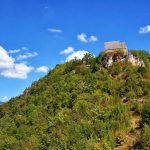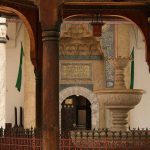At the mention of any Herzegovina čaršija (old bazaar), the first thing that comes to mind is the sun. Although situated at the border with the colder Bosnia, Konjic is no exception either, however it is not uncommon for it to be enveloped by lower temperatures compared to its southern counterparts.

The border between regional parts of Bosnia and Herzegovina is the most striking in this area. Therefore, it can happen that in winter, while you are passing through the tunnel which starts in Konjic and ends in the Sarajevo canton, you witness a total weather transformation due to the snow that has already fallen.
Numerous national monuments
Konjic is one of the oldest towns of our country and it is impossible to write about all the landmarks that are part of its heritage in just one article, especially if one takes into account the information that archeological traces date back to as far as four thousand years ago.
In this town where you can take a pleasant stroll around, the first written traces date all the way back to the year 1382, and it is thought that it was founded as a border town of the Hum country on an important road connecting Bosnia with Dubrovnik.
During the Middle Ages it was under the rule of Sandalj Hranić, the Bosnian Kingdom’s duke, who was succeeded by Stjepan Vukčić – Kosača after his death. In the 15th century, the Ottomans came onto the scene and started constructing buildings typical of that time, such as han and caravansaray (roadside inns where travelers could rest), however all the later historical periods also left their mark here.
Passing through the town, it is hard not to notice the eye-catching national monument, the old Kamena ćuprija (Stone Bridge) built in 1682. The bridge witnessed different historical periods and is known as an architectural masterpiece of the 17th century. However, in 1945, during the WWII German troop withdrawal, the bridge was bombarded and destroyed. The only remaining parts were stone columns, however, in 2009 the bridge was fully restored.
 In the town center of Konjic there is a religious building complex and yet another national monument – Franjevački samostan and crkva sv. Ivana Krstitelja (Franciscan monastery and St Ivan’s Church). Unlike the monastery building which was completed in 1939 and 1940, the church was built between 1895 and 1897, while its interior was completed in 1909 and the bell tower in 1919. The monastery museum is filled with relics, including paintings, sculptures, books, priests’ robes and chalices, as well as an ethnological collection.
In the town center of Konjic there is a religious building complex and yet another national monument – Franjevački samostan and crkva sv. Ivana Krstitelja (Franciscan monastery and St Ivan’s Church). Unlike the monastery building which was completed in 1939 and 1940, the church was built between 1895 and 1897, while its interior was completed in 1909 and the bell tower in 1919. The monastery museum is filled with relics, including paintings, sculptures, books, priests’ robes and chalices, as well as an ethnological collection.
The only mosque in Konjic nestled on the right bank of the Neretva River is Repovačka džamija, an architectural piece from 1579, which is associated with Hudaverdi Mehmed-čauš Bosna, a descendant of the aristocratic Repovac bey family. The legend says that he instructed the mosque builders to build the minaret on the left side of the river –the ‘heart side’, in memory of his deceased wife and daughter. The mosque is also a national monument.
Another religious monument which should be mentioned is Hram sv. Vasilija Velikog (the Ortodox Church of St Basil the Great). Its construction on the Varda locality in Konjic at the beginning of 1885 was met with delight among locals back then. Ten years ago, the church and its movable property – the icons were given the status of a national monument by the Commission to Preserve National Monuments of Bosnia and Herzegovina.
Zulfikar “Zuko” Džumhur
It is well known that the town on the Neretva River is also the birthplace of the famous travel writer, painter and cartoonist – Zuko Džumhur. He was made famous by his cartoon depicting a Stalin portrait hung on Karl Marx’s office wall while the latter is writing his Kapital. Allegedly, even Josip Broz Tito became fond of Džumhur after seeing this cartoon.
 The family home of this great man is part of the Native Land Museum in Konjic. The museum was established six years ago, and it quickly became the main source of education about Konjic, its past, region and natural heritage.
The family home of this great man is part of the Native Land Museum in Konjic. The museum was established six years ago, and it quickly became the main source of education about Konjic, its past, region and natural heritage.
The Konjic region is rich in medieval tombstones called stećci. The most numerous ones are those in the form of a chest, while the ridge-roofed or slab-shaped ones are represented equally. The necropolises are found in different localities, among them Ravnice in village Dubočani, 11,61 kilometers south-east from Konjic. This site comprises of 49 burial stones. On the way from Bradina to Repovci, in Velika village, 78 stećci were discovered on the location of Mašeti. Yet at another location 2,5 kilometers east from Čičev village, there is a stećak necropolis called Ograda Vlah. This national monument consists of 16 graves with stećci: 15 chests and one tall ridge-roofed stećak.
Another interesting place in the Konjic region is Šurkovića kula, an old feudal, Muslim manor house. The house is located in Odžaci, among the mountains Visočica, Treskavica and Crvnja. It was built on an incline and was solely used for habitation purposes.
 Relaxing in Nature
Relaxing in Nature
Boračko lake is a tourist gem of Konjic. This is the largest mountain lake in Bosnia and Herzegovina, surrounded by conifer and deciduous forests and Prenj, Visočica and Bjelašnica mountains. The lake attracts a great number of local and international guests who enjoy relaxing, swimming and tracking in the beautiful surroundings.
 White water rafting on the fast-moving Neretva river attracts a growing number of tourists each year. The most interesting rafting track is the one from Glavatičevo to Konjic. A few adrenaline-packed hours of rafting take you from Little and Big Canyon through the untouched natural beauty.
White water rafting on the fast-moving Neretva river attracts a growing number of tourists each year. The most interesting rafting track is the one from Glavatičevo to Konjic. A few adrenaline-packed hours of rafting take you from Little and Big Canyon through the untouched natural beauty.
The art of woodworking
The long local tradition of woodworking is still nurtured in Konjic. The families Mulić and Nikšić are guardians of this one hundred-year- old tradition that was brought to Konjic by woodworkers from Herzegovina and during the Austro-Hungarian monarchy period it turned into an art form.
 Tito’s bunker
Tito’s bunker
Not far from Konjic on the Zlatar mountain, there is a nuclear shelter, commonly known as Tito’s Bunker. The building of the shelter has lasted for 26 years and cost 4,6 billion dollars. Because of its size – it is over 20.000 m2, containing 100 rooms, offices and conference rooms, it is obvious that it was built for the military and political leadership of ex-Yugoslavia. The shelter was able to accommodate 350 people for the duration of six months and with no contact with the outside world.




